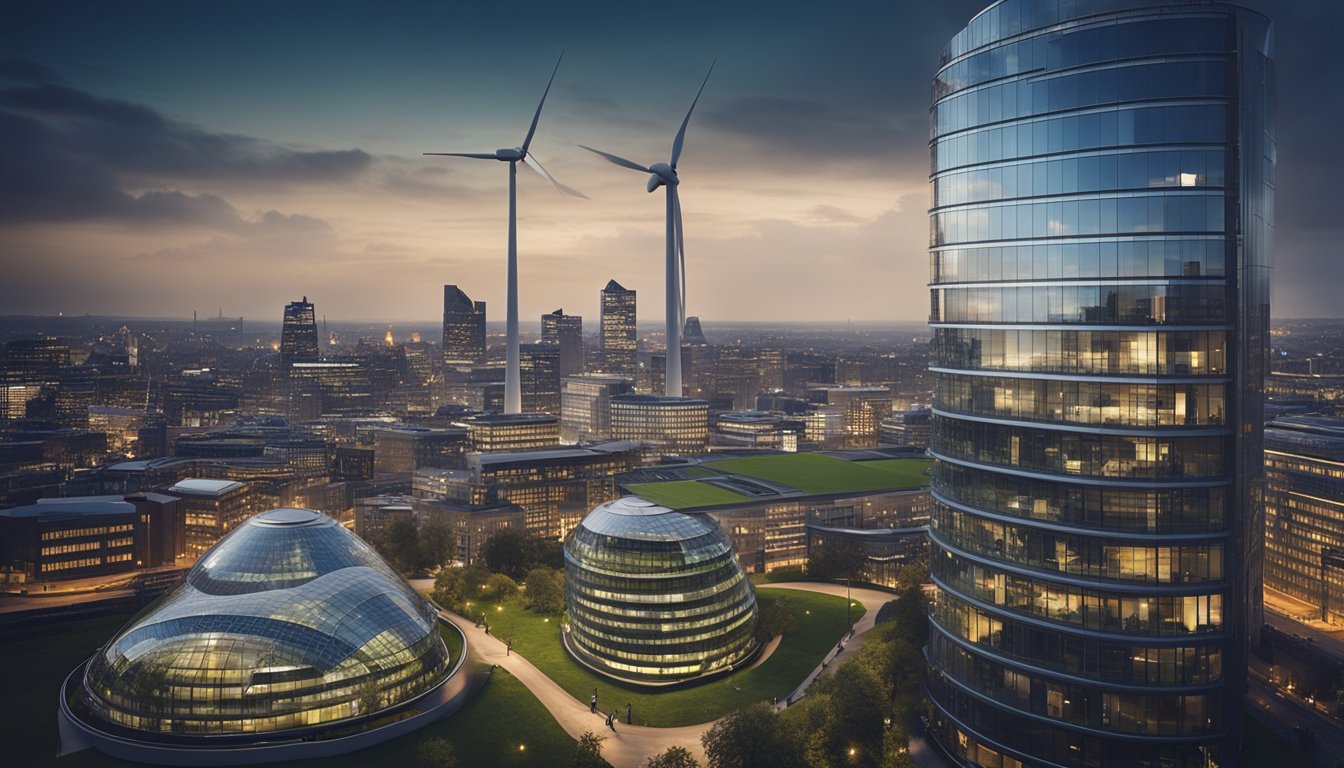Late updated: 14 Jan 2025 15:01
Written by: Amber Collins
Implementing Green IT Solutions for UK Businesses: A Sustainable Approach
In today's rapidly evolving business landscape, the urgency for environmental sustainability is reshaping how UK businesses operate. By integrating Green IT solutions, companies can minimise their ecological footprint while reaping technological benefits. Adopting sustainable IT practices is not just an ethical choice; it's a strategic move that enhances operational efficiency and reduces costs.

Our journey into Green IT delves into the essential steps UK businesses must take to adapt to this new paradigm. By prioritising energy-efficient technologies and adhering to environmental regulations, organisations are setting themselves up for long-term success. This commitment not only meets compliance requirements but fosters a culture of sustainability within the workplace.
With a dynamic mix of initiatives, from upgrading to energy-efficient servers to leveraging green finance platforms, businesses can significantly impact the environment. Green IT isn't just for large corporations; small and medium-sized enterprises can also make considerable strides. As we explore these strategies, let’s discover how these transformations can be practically implemented and the substantial benefits they bring.
Key Takeaways
- Green IT solutions enhance efficiency and reduce costs.
- Sustainable practices are crucial for business success.
- SMEs can significantly impact environmental sustainability.
Laying the Foundations for Sustainable IT

As businesses move towards a more sustainable future, implementing sustainable IT practices plays a critical role. We must focus on increasing energy efficiency, developing effective recycling programmes, and adopting green technology to reduce our environmental impact.
Understanding Green IT and Its Importance
Green IT involves incorporating sustainable practices into our technology usage to minimise environmental impact. By adopting energy-efficient hardware and optimising IT infrastructure, we can reduce greenhouse gas emissions. Implementing green solutions not only supports environmental responsibility but also ensures compliance with regulations.
The importance lies in achieving energy savings and enhancing operational efficiency while contributing to a sustainable future. Moreover, sustainable IT practices help us meet regulatory requirements and reduce overall costs.
Assessing Current IT Infrastructure for Energy Efficiency
To lay a solid foundation for sustainable IT, assessing the energy efficiency of existing IT infrastructure is essential. We start by evaluating our servers, network equipment, and workstations to identify energy consumption patterns. Understanding these trends allows us to pinpoint inefficiencies.
One actionable step is to replace outdated hardware with energy-efficient alternatives. For instance, energy-saving servers and cooling systems help reduce electricity consumption. Implementing monitoring tools can further enable us to maintain optimal energy usage in the long term.
Developing Green Procurement Policies
Adapting our procurement strategies to prioritise sustainability forms a crucial aspect of green IT. By creating green procurement policies, we can focus on sourcing environmentally-friendly products and services. This includes selecting vendors who demonstrate a commitment to sustainability.
When procuring IT products, prioritise energy-efficient devices, reduced packaging, and products with eco-certifications. Our policies should also encourage suppliers to adopt sustainable practices. This shift not only supports our environmental goals but highlights our dedication to sustainability to stakeholders.
Recycling Programmes and Reducing Electronic Waste
An effective recycling programme is vital for minimising electronic waste and promoting sustainability. Our initiative starts with identifying and properly disposing of outdated electronics, such as computers and peripherals. Partnering with certified e-waste recycling firms ensures responsible disposal and recovery of valuable materials.
We can also implement internal recycling initiatives, encouraging employees to recycle and reuse electronic components. By raising awareness about the importance of reducing e-waste, we reinforce our commitment to a sustainable future. It is essential to track performance regularly, aiming to continually improve our waste reduction strategies.
Strategic Implementation and Benefits of Green Solutions
Incorporating Green IT solutions offers substantial benefits for UK businesses. Through renewable energy, cloud services, cost efficiencies, and collaborative practices, companies can significantly reduce their carbon footprint and improve sustainability while gaining a competitive edge.
Incorporating Renewable Energy and Eco-friendly Technology
By incorporating renewable energy and eco-friendly technology, businesses can dramatically decrease their energy consumption and carbon footprint. In London, more firms are investing in energy-efficient lighting and solar panels, aligning with corporate responsibility towards climate change mitigation.
Renewable energy solutions like wind and solar offer a pathway to sustainable IT operations. Meanwhile, adopting eco-friendly technologies such as green computing helps reduce resource consumption. As companies take these steps, not only do they contribute to environmental sustainability, but they also enhance their brand image as leaders in responsible business practices.
Advantages of Cloud Services and Data Centres
Cloud solutions and modern data centres provide numerous benefits by improving efficiency and reducing waste. By moving operations to the cloud, we minimise energy expenditure, as these platforms often utilise state-of-the-art energy-efficient technologies.
This transition supports business sustainability as serverless computing reduces the need for in-house physical servers. Additionally, cloud services enable data-driven decisions that optimise operations and resource utilisation. Therefore, the flexibility and scalability of cloud technology can lead to substantial productivity advancements and bolster corporate sustainability strategies.
Maximising Cost Savings and Operational Efficiency
Implementing sustainable IT solutions paves the way for maximising cost savings and enhancing operational efficiency. UK businesses, including SMEs, benefit from adopting energy-efficient infrastructure which reduces utility bills and operational costs over time.
Furthermore, strategies such as using IT equipment that generates less heat and applying energy-efficient cooling systems significantly lower energy consumption costs. We aim to achieve financial savings while boosting productivity through these initiatives. As a result, our efforts encourage waste reduction and create avenues for reinvestment in further sustainable improvements within our operations.
Fostering Collaboration and Achieving Competitive Advantage
Collaboration across sectors is crucial in realising the full potential of green IT strategies. By working closely with partners and stakeholders, we can develop comprehensive solutions that enhance business wider benefits.
Sharing resources and insights enables us to innovate effectively, staying ahead in competitive markets. Companies adopting such strategies not only gain a competitive advantage but also strengthen their commitment to social and environmental responsibilities. This openness to collaboration is essential to advancing green technology and ensuring robust, sustainable growth in the marketplace.
Frequently Asked Questions

In this section, we'll address common questions about how UK businesses can implement Green IT solutions. We'll explore the best strategies, technologies, and practices that offer substantial benefits while also adhering to regulatory compliance.
How can UK businesses reduce their carbon footprint through technology?
UK businesses can significantly reduce their carbon footprint by adopting eco-friendly technologies. Implementing virtualisation and cloud computing reduces the need for physical servers. Utilising energy-efficient hardware in day-to-day operations further minimises energy consumption and greenhouse gas emissions.
What strategies can companies employ to integrate sustainability in IT?
Companies can start by conducting audits to identify areas for improvement. Setting clear sustainability goals, such as reducing energy usage by a certain percentage, is essential. Opting for renewable energy sources to power IT infrastructure, along with practising responsible vendor management, is crucial for comprehensive sustainability integration.
Which green technologies offer the best ROI for UK businesses?
Energy-efficient servers and cloud solutions often provide the highest return on investment. While initial costs may be high, long-term savings from reduced energy bills and maintenance can be substantial. Investing in software that monitors and optimises energy consumption can also provide solid ROI.
What are the regulatory considerations for UK businesses adopting eco-friendly IT?
Businesses must be aware of the UK Emissions Trading Scheme, which impacts how emissions reductions are valued and managed. Compliance with waste electrical and electronic equipment (WEEE) regulations is essential. Staying informed about government incentives for green technology investments also gives companies a competitive edge.
In what ways can energy efficiency be optimised in corporate data centres?
Energy efficiency in data centres can be enhanced by employing advanced cooling technologies and airflow management. Implementing real-time energy monitoring systems helps with precise adjustments, ensuring optimal efficiency. Utilising virtualisation can also reduce the number of physical servers needed, lowering overall energy use.
What are the best practices for electronic waste management in the UK business sector?
Proper e-waste management includes partnering with certified recycling firms to dispose of old equipment responsibly. Data wiping and asset recovery are essential before equipment recycling. Encouraging a culture of recycling and regular training on the importance of responsible disposal are also vital practices.
